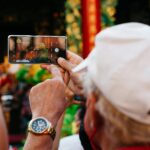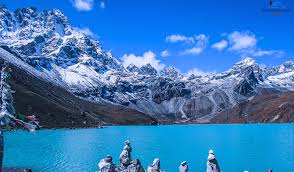Embarking on the Everest Base Camp and Gokyo Lake trek is a journey that promises not just breathtaking views but an adventure of a lifetime. This trek combines two of the most iconic routes in the Everest region, offering trekkers a chance to experience the diverse landscapes, rich culture, and high-altitude wonders of the Himalayas.
The adventure begins in Kathmandu, where trekkers are introduced to the vibrant culture of Nepal before flying to Lukla, the gateway to the Everest region. From Lukla, the trek follows the well-trodden path to Everest Base Camp, weaving through lush forests, quaint Sherpa villages, and ancient monasteries. The journey to Everest Base Camp is exhilarating, with every step bringing trekkers closer to the majestic peak of Mount Everest. Along the way, the views of Everest, Lhotse, and Nuptse create a dramatic backdrop, enhancing the trek’s grandeur.
After reaching Everest Base Camp, trekkers embark on a detour to the Gokyo Valley. This portion of the trek offers a contrasting yet equally stunning experience. The trail climbs through rugged terrain and serene alpine meadows, leading to the Gokyo Lakes, a series of pristine, turquoise lakes nestled amidst towering peaks. The Gokyo Lakes are a highlight of the trek, offering a tranquil escape and spectacular photographic opportunities. The surrounding peaks, including Cho Oyu and Makalu, provide a breathtaking panorama that contrasts beautifully with the icy expanse of Everest.
One of the unique features of this trek is the ascent to Gokyo Ri, a summit that provides a panoramic view of the Everest region that rivals any viewpoint on the trek. From this vantage point, trekkers can gaze upon the stunning array of peaks, including Everest, and the serene Gokyo Lakes below. The sunrise view from Gokyo Ri is particularly magical, with the first light casting a golden glow over the Himalayas.
The trek is demanding, with high altitudes presenting challenges that require careful acclimatization and physical preparation. However, the rewards are substantial, with each day presenting new and awe-inspiring landscapes. The trek not only offers unparalleled views but also immerses trekkers in the culture and daily life of the Sherpa people. Staying in local teahouses and interacting with the warm and hospitable Sherpas provides a deeper connection to the region.
In essence, the Everest Base Camp and Gokyo Lake trek is a grand adventure that captures the essence of the Himalayas. It combines the iconic allure of Everest with the serene beauty of the Gokyo Lakes, delivering a trekking experience that is both challenging and profoundly rewarding. For those seeking an epic journey through some of the world’s most stunning terrain, this trek stands as a pinnacle of adventure, promising memories that will last a lifetime.
Introduction to the Everest Base Camp & Gokyo Lake Trek
The Everest Base Camp and Gokyo Lake trek is a premier adventure in Nepal, offering trekkers an unparalleled opportunity to explore some of the most stunning landscapes in the Himalayas. Combining the classic Everest Base Camp route with the serene Gokyo Lakes, this trek provides a comprehensive experience of the Everest region’s natural beauty and cultural richness. Beginning with a scenic flight from Kathmandu to Lukla, trekkers traverse through picturesque Sherpa villages, lush forests, and rugged mountain terrain. The journey leads first to Everest Base Camp, where climbers and adventurers gather before attempting the world’s highest peak. After absorbing the awe-inspiring views at Base Camp, the trek continues to the Gokyo Valley, renowned for its striking glacial lakes and panoramic mountain vistas. This trek offers a blend of high-altitude trekking challenges, rewarding landscapes, and a deep immersion into the local Sherpa culture. It is an ideal choice for those seeking an adventurous and diverse Himalayan experience.
Overview of the Trekking Route
The Everest Base Camp and Gokyo Lake trek unfolds in two main segments. The trek starts with a flight to Lukla, followed by a journey through the Everest region’s traditional Sherpa villages, such as Namche Bazaar and Tengboche, to reach Everest Base Camp. This segment allows trekkers to acclimatize and absorb the grandeur of Everest and surrounding peaks. After reaching Base Camp, the route diverges towards the Gokyo Valley. The path to Gokyo takes trekkers through alpine meadows and rugged terrain, eventually arriving at the beautiful Gokyo Lakes. Highlights include the climb to Gokyo Ri, which offers breathtaking views of Everest, Makalu, and Cho Oyu. The trek then retraces the route back to Lukla, concluding with a flight back to Kathmandu. This combination of iconic viewpoints and serene lakes makes the route both challenging and rewarding.
Best Time to Trek
The ideal times to undertake the EBC Trek and Gokyo Lake trek are during the pre-monsoon (spring) and post-monsoon (autumn) seasons. Spring, from late March to early May, provides clear skies and stable weather, making it the most popular time for trekking. The temperatures are moderate, and the views of the snow-capped peaks are spectacular. Autumn, from late September to early November, also offers clear skies and favorable trekking conditions. Temperatures are cooler but manageable, and the trails are less crowded compared to spring. Winter, with its harsh cold and snow, and summer, with the monsoon rains, are less ideal due to challenging weather conditions and potential trail hazards. Choosing the right season ensures optimal trekking conditions and a more enjoyable experience in the Himalayas.
Essential Gear and Packing List
Proper preparation is crucial for the Everest Base Camp and Gokyo Lake trek due to the high-altitude environment and variable weather conditions. Essential gear includes a high-quality trekking backpack, a down jacket, thermal layers, and a good pair of trekking boots. Layering is important, so pack moisture-wicking base layers, insulating mid-layers, and a waterproof outer shell. Don’t forget trekking poles, a hat, gloves, sunglasses, and a sunblock to protect against sun exposure at high altitudes. A sleeping bag rated for cold temperatures, a headlamp, and a first aid kit are also necessary. Additionally, bring personal items like water purification tablets, snacks, and a camera. Packing efficiently and ensuring you have all the necessary gear will enhance your comfort and safety throughout the trek.
Permits and Regulations
To trek to Everest Base Camp and Gokyo Lake, obtaining the necessary permits is crucial. The most essential permits are the Sagarmatha National Park Permit and the TIMS (Trekkers’ Information Management System) card. The Sagarmatha National Park Permit is required to enter the protected area encompassing Everest and Gokyo, while the TIMS card helps in managing and tracking trekkers for safety purposes. Both permits can be obtained through authorized trekking agencies in Kathmandu or at the park’s entry points. It is important to ensure that your permits are up-to-date and valid for the duration of your trek. Additionally, respecting local regulations, following designated trails, and adhering to environmental guidelines help preserve the natural beauty and cultural heritage of the Everest region.
Acclimatization and Altitude Sickness
Acclimatization is a critical aspect of the Everest Base Camp and Gokyo Lake trek, given the high altitudes trekkers will encounter. Proper acclimatization helps your body adjust to the decreased oxygen levels, reducing the risk of altitude sickness. The trek is designed with gradual elevation gains to allow for acclimatization. Key strategies include taking rest days, such as the acclimatization day at Namche Bazaar, where trekkers can explore nearby areas at a higher altitude without pushing further up the trail. Symptoms of altitude sickness can range from mild, such as headaches and nausea, to severe, including shortness of breath and confusion. To mitigate these risks, it’s important to stay hydrated, avoid overexertion, and be prepared to descend if symptoms worsen. Carrying medications like acetazolamide can help, but it is crucial to listen to your body and consult with guides and medical professionals if needed. By following these acclimatization strategies, you can enhance your safety and enjoyment of the trek.
Daily Itinerary Overview
The Everest Base Camp and Gokyo Lake trek typically spans around 18 to 20 days, with a well-structured itinerary to balance trekking with acclimatization and exploration. The journey begins with a flight from Kathmandu to Lukla, followed by a trek to Phakding and then to Namche Bazaar. After acclimatizing in Namche, the route continues to Tengboche and then to Dingboche, where another acclimatization day helps prepare for higher altitudes. From Dingboche, trekkers proceed to Everest Base Camp, enjoying the stunning views and vibrant atmosphere. The itinerary then shifts towards the Gokyo Valley, with stops at the picturesque Gokyo Lakes and a climb to Gokyo Ri for panoramic vistas. The trek concludes with a return journey to Lukla and a flight back to Kathmandu. This carefully planned itinerary ensures a balanced pace, allowing for both the physical demands of high-altitude trekking and the opportunity to fully appreciate the region’s natural and cultural highlights.
Cultural Insights and Local Communities
The Everest Base Camp trek offers a rich immersion into the cultural heritage of the Sherpa people, who are integral to the region’s history and daily life. Trekking through the Everest region, you’ll encounter traditional Sherpa villages such as Namche Bazaar, Tengboche, and Dingboche. These communities are known for their warm hospitality, vibrant Buddhist culture, and unique customs. Visiting monasteries like Tengboche Monastery provides insights into local spiritual practices and the role of Buddhism in everyday life. Local festivals, such as Dashain and Tihar, often coincide with trekking seasons, offering an opportunity to witness traditional celebrations and rituals. Engaging with the Sherpas, learning about their way of life, and observing their daily routines enriches the trekking experience, providing a deeper understanding of the region beyond its natural beauty.
Wildlife and Natural Beauty
The Everest Base Camp and Gokyo Lake trek is a feast for nature lovers, showcasing diverse landscapes and a variety of wildlife. As you ascend through different altitudes, you’ll encounter lush forests of pine and rhododendron, alpine meadows, and stark, rocky terrain. The trek passes through Sagarmatha National Park, home to unique flora and fauna adapted to high-altitude environments. Wildlife sightings may include the elusive snow leopard, Himalayan tahr, and the iconic red panda. Bird enthusiasts can spot species like the Himalayan griffon vulture and the Danphe, or Himalayan pheasant, which is Nepal’s national bird. The Gokyo Lakes area offers particularly stunning vistas, with the turquoise waters of the lakes set against the backdrop of towering snow-capped peaks. This blend of dramatic landscapes and rich biodiversity makes the trek a remarkable journey through some of the Himalayas’ most pristine environments.
Trekking Tips for First-Timers
For those new to high-altitude trekking, the Everest Base Camp and Gokyo Lake trek can be both exhilarating and challenging. Preparation is key to a successful experience. Start by engaging in regular physical training to build endurance and strength, focusing on cardio and leg workouts. Understanding the basics of high-altitude trekking, including acclimatization strategies and recognizing signs of altitude sickness, is essential. Invest in quality gear, such as well-fitted trekking boots and layered clothing, and ensure you are prepared for varying weather conditions. It’s also important to stay hydrated and eat a balanced diet to maintain energy levels. Consider hiring a guide or joining a reputable trekking group, which can provide support, local knowledge, and ensure safety. Finally, be prepared for a range of emotions and physical challenges, from awe-inspiring views to strenuous climbs. Embrace the journey with an open mind and a flexible attitude, and you’ll be well on your way to a memorable trekking adventure.
Safety Considerations
Ensuring safety during the Everest Base Camp and Gokyo Lake trek involves careful preparation and vigilance. Altitude sickness is a significant concern, so acclimatization is crucial. Follow a gradual ascent schedule and allow time for rest days, especially at higher altitudes, to give your body time to adjust. Stay hydrated, avoid overexertion, and be aware of symptoms such as headaches, nausea, and dizziness. Carry a first aid kit and medications like acetazolamide for altitude sickness. Weather conditions can be unpredictable, so monitor forecasts and prepare for sudden changes by packing appropriate clothing and gear. Always trek with a guide or in a group to ensure safety and navigation support. Emergency evacuation plans should be in place, and travel insurance that covers high-altitude trekking is highly recommended. Additionally, be mindful of the local environment and follow guidelines to minimize your impact on the natural surroundings.
Recommended Accommodation
Accommodation on the Everest Base Camp and Gokyo Lake trek varies from basic teahouses to more comfortable lodges. In villages like Namche Bazaar and Lukla, you’ll find more modern lodgings with additional amenities. As you trek higher, accommodations become more basic but still offer essential comforts like a warm bed and communal dining. Teahouses are simple, family-run establishments where you’ll experience local hospitality and can enjoy traditional Nepali meals. In places such as Dingboche and Gokyo, accommodations are more basic due to the remote location. It’s advisable to book in advance, especially during peak trekking seasons, to secure your stay. While teahouses provide a fundamental level of comfort, be prepared for basic facilities and shared bathrooms. Bringing a sleeping bag for extra warmth is also a good idea, as higher altitudes can be quite cold.
Photography Tips for Stunning Landscapes
Capturing the breathtaking landscapes of the Everest Base Camp and Gokyo Lake trek requires a bit of planning and technique. Start by using a camera with manual settings to control exposure, aperture, and shutter speed. Early mornings and late afternoons provide the best light for landscape photography, with softer, golden hues and dramatic shadows. For capturing the majestic peaks and vast scenery, use a wide-angle lens to encompass the grandeur of the mountains and lakes. Consider a tripod for stability, especially in low light or during long exposure shots of star-filled skies. Pay attention to composition by including elements such as leading lines, foreground interest, and the rule of thirds to enhance your images. Don’t forget to capture the local culture and daily life, which adds depth to your photo story. Finally, respect local customs and request permission before photographing individuals.
Post-Trek Reflections
Reflecting on your Everest Base Camp and Gokyo Lake trek is a rewarding part of the journey. After returning, take time to review the experiences and memories gained. Consider keeping a journal or writing about your trek to preserve the details of your adventure and the personal challenges you overcame. Reflect on the natural beauty you encountered, the cultural insights gained from interacting with the Sherpa people, and the physical and emotional achievements of completing the trek. Share your experiences with others through blog posts, social media, or presentations, and consider how the trek has impacted your perspective on adventure and travel. This reflection not only helps in cherishing the memories but also in appreciating the journey’s impact on your personal growth and understanding of the Himalayas.
Resources and Further Reading
To deepen your understanding and preparation for the Everest Base Camp and Gokyo Lake trek, several resources can be invaluable. Guidebooks such as “Trekking in Nepal: A Traveler’s Guide” by Jamie McGuinness provide detailed information on the trek, including maps and tips. Websites like the Himalayan Database and trekking forums offer up-to-date information and personal experiences from other trekkers. For cultural and environmental insights, books like “Everest: The Remarkable Story of Everest’s Highest Peak” by Frank Smythe offer historical perspectives. Documentaries and travelogues, such as “The Wildest Dream” and “Everest” (2015), provide visual and narrative insights into the Everest region. Additionally, consulting with trekking agencies and local guides can offer tailored advice and current conditions. Engaging with these resources will enhance your preparation and enrich your overall trekking experience.









